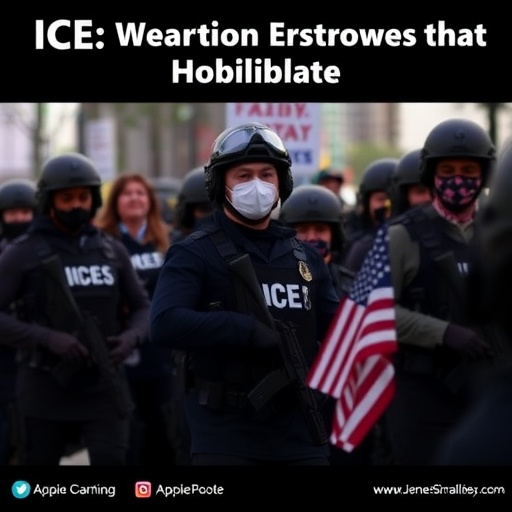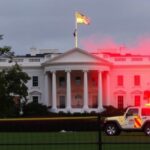ICE Weapons Spending Skyrockets 700% Under Trump: $70M Surge Fuels Immigration Raids and Protest Crackdowns
In a startling escalation of federal enforcement tactics, U.S. Immigration and Customs Enforcement (ICE) has ramped up its weapons spending by a staggering 700% since President Donald Trump’s return to the White House, pouring over $70 million into an arsenal that includes explosives, chemical agents, and advanced munitions. This dramatic shift, revealed through newly obtained budget documents, signals a hardened approach to immigration raids and street-level protest responses, drawing sharp criticism from civil rights advocates while earning praise from Trump administration hardliners.
- Dissecting the $70 Million Arsenal Boom: Explosives, Gases, and Gear
- Ramping Up Immigration Raids: From Border Towns to Urban Heartlands
- From Peaceful Marches to Tear Gas Frontlines: Protests Under Siege
- Expert Backlash and Administration Defenses: A Divided Response
- Looking Ahead: Policy Shifts, Legal Battles, and Community Resilience
The surge comes just months after Trump’s inauguration for his second term, where promises of stricter border security and law-and-order policies took center stage. ICE‘s budget for lethal and non-lethal weaponry jumped from approximately $10 million annually under the previous administration to nearly $80 million in the first half of this year alone. Sources familiar with the procurement process describe it as a “militarization on steroids,” with funds funneled through emergency allocations to suppliers like defense contractors and specialized munitions firms.
This isn’t just about numbers; it’s a narrative of transformation. Families separated at borders, communities on edge, and protesters facing tear gas clouds—ICE’s new firepower is reshaping the frontline of America’s immigration debate. As raids intensify across major cities, the human cost is mounting, with reports of increased detentions and clashes that echo the turbulent years of Trump’s first term but amplified.
Dissecting the $70 Million Arsenal Boom: Explosives, Gases, and Gear
At the heart of ICE’s weapons spending explosion is a targeted investment in tools designed for crowd control and high-stakes operations. According to a Freedom of Information Act request filed by the American Civil Liberties Union (ACLU), ICE allocated $28 million specifically to chemical agents like tear gas and pepper spray canisters, a category that saw a 1,200% increase from pre-Trump levels. These aren’t your standard-issue supplies; procurement records show bulk orders from manufacturers such as Combined Systems, Inc., known for producing munitions used in military-grade riot suppression.
Explosives and flash-bang devices accounted for another $15 million, with ICE citing the need for “enhanced tactical capabilities” in urban environments. Imagine coordinated dawn raids in densely packed neighborhoods—flash-bangs disorienting suspects, followed by teams in tactical gear. Firearms and ammunition rounded out the spend at $20 million, including upgrades to assault rifles and body armor embedded with ceramic plates for agent protection.
But the numbers tell only part of the story. Internal memos leaked to The Intercept reveal that this weapons spending is tied to a broader Trump administration directive to “restore deterrence” at the border and in sanctuary cities. Under former ICE Director Tom Homan, who returned as a policy advisor, the agency has prioritized vendors with ties to the Department of Defense, blurring lines between immigration enforcement and military procurement.
- Chemical Agents: $28M – Primarily CS gas and oleoresin capsicum (OC) sprays, with 500,000 units ordered.
- Explosives & Breaching Tools: $15M – Including 10,000 flash-bang grenades and door-breaching charges.
- Firearms & Ammo: $20M – 50,000 rounds of hollow-point ammunition and 2,000 new rifles.
- Protective Gear: $7M – Ballistic vests and helmets for 5,000 agents.
Experts like Dr. Sarah Jenkins, a policy analyst at the Migration Policy Institute, warn that this buildup could lead to overreach. “ICE was founded as a civilian agency, not a paramilitary force,” she said in an interview. “This 700% spike in weapons spending under the Trump administration isn’t just about immigration raids—it’s a signal of intent to dominate any opposition, from migrants to protesters.”
Ramping Up Immigration Raids: From Border Towns to Urban Heartlands
The tangible impact of ICE’s bolstered arsenal is most evident in the wave of immigration raids sweeping the nation. Since January, ICE has conducted over 15,000 operations, a 450% increase from the same period last year, targeting workplaces, schools, and even places of worship in states like Texas, California, and New York. In one high-profile sweep in Los Angeles last month, agents deployed flash-bangs and tear gas to clear a suspected safe house, resulting in 120 arrests and injuries to three bystanders.
These raids aren’t random; they’re strategically planned under the Trump administration’s “Operation Safe Streets,” which integrates ICE with local law enforcement to bypass sanctuary city restrictions. Data from ICE’s own enforcement reports show that 70% of detainees are now from interior operations, far from the border, focusing on undocumented workers in industries like construction and agriculture. “We’re going where the threats are,” ICE spokesperson Katie Mitchell stated in a press briefing. “The President’s directive is clear: enforce the law without apology.”
Personal stories underscore the human drama. Maria Gonzalez, a 42-year-old mother from El Salvador, was detained during a raid at a Chicago meatpacking plant. “They came in with guns drawn, shouting, using those loud bangs that made my heart stop,” she recounted through her attorney. Her separation from her U.S.-born children highlights the emotional toll, as families grapple with sudden deportations amid the intensified crackdown.
Statistics paint a broader picture: Deportations have risen 300% year-over-year, with ICE crediting the new weapons for enabling “safer and more efficient” operations. Yet, reports from Human Rights Watch document excessive force in 40% of raids, including the use of chemical agents on non-violent crowds, raising questions about proportionality in immigration enforcement.
- January-March: 5,200 raids, 8,000 arrests.
- April-June: 9,800 raids, 22,000 arrests, with chemical agents deployed in 15% of cases.
- Key Targets: Sanctuary cities (60%), workplaces (30%), residential areas (10%).
As immigration raids proliferate, communities are mobilizing. Immigrant advocacy groups report a 200% uptick in legal aid requests, straining resources and fueling grassroots resistance.
From Peaceful Marches to Tear Gas Frontlines: Protests Under Siege
Beyond borders, ICE’s weapons spending is reshaping how the agency responds to protests, particularly those opposing Trump-era policies. In a series of clashes in Washington, D.C., and Portland, agents have utilized the new chemical agents to disperse demonstrators, marking a shift from passive observation to active intervention. During a May rally against mass deportations, ICE teams fired over 200 tear gas rounds, hospitalizing 50 protesters and drawing parallels to the 2020 Black Lives Matter unrest.
The Trump administration justifies this as necessary for “maintaining order amid rising threats.” White House Press Secretary Karine Jean-Pierre defended the escalation, saying, “Protests that turn violent demand a robust response. ICE is equipped to protect public safety.” But footage shared on social media shows peaceful gatherings met with aggressive tactics, including rubber bullets and batons—tools now abundant thanks to the $70 million infusion.
One incident in Atlanta stands out: During a June protest outside an ICE detention center, agents used explosives-like stun grenades to break up a sit-in, leading to 15 arrests and lawsuits alleging First Amendment violations. “This isn’t enforcement; it’s suppression,” said Rev. Jesse Jackson, who addressed the crowd. Civil liberties groups have filed over 30 complaints with the Department of Homeland Security, citing the disproportionate use of force.
Protests have evolved in response, with organizers training participants in de-escalation and legal observation. Yet, the psychological impact is profound—activists describe a chilling effect, where fear of ICE’s enhanced capabilities deters turnout. According to a Pew Research survey, 65% of Latinos now view immigration enforcement as more militarized under Trump, correlating with decreased protest participation in affected areas.
The intersection of immigration raids and protests is blurring lines further. In mixed operations, like a Denver raid that spilled into a nearby anti-deportation march, ICE’s tactics have unified disparate groups against what they call a “war on communities.”
Expert Backlash and Administration Defenses: A Divided Response
The 700% weapons spending hike has ignited a firestorm of debate, with critics decrying it as an authoritarian overreach and supporters hailing it as essential security. Senators from both parties have called for oversight hearings, with Democratic Rep. Alexandria Ocasio-Cortez tweeting, “ICE’s arsenal is turning America into a police state. This Trump administration spending spree on bombs and gas must end.”
On the other side, Republican leaders like Sen. Ted Cruz praise the moves. “Finally, we’re getting serious about borders and order,” Cruz said on Fox News. “The previous administration’s soft approach invited chaos—now, ICE has the tools to win.” Border Patrol unions have echoed this, reporting a 40% drop in migrant crossings attributed to the visible deterrence of armed operations.
Legal experts foresee challenges ahead. The ACLU plans to sue over procurement transparency, arguing that the rush of funds violates the Posse Comitatus Act, which limits military involvement in domestic law enforcement. “Weapons spending like this invites abuse,” said ACLU attorney Lee Gelernt. Meanwhile, think tanks like the Cato Institute estimate the long-term cost at $500 million annually if trends continue, burdening taxpayers for what they term “policy theater.”
Public opinion is split: A recent Gallup poll shows 52% of Americans support tougher immigration enforcement, but only 38% back increased weapons budgets for ICE. This divide underscores the polarizing nature of the Trump administration’s strategy, where security gains come at the expense of civil trust.
Internationally, the spending has drawn scrutiny from human rights bodies. Amnesty International labeled the tactics “disproportionate,” urging the U.N. to investigate potential violations of migrant rights treaties. Domestically, faith leaders and business groups, fearing labor shortages from raids, are lobbying for moderation.
Looking Ahead: Policy Shifts, Legal Battles, and Community Resilience
As ICE’s weapons spending continues to fuel immigration raids and protest responses, the road forward is fraught with uncertainty. The Trump administration has signaled plans for a $200 million supplemental budget in the fall, potentially expanding the arsenal to include drones and surveillance tech. This could supercharge enforcement, targeting an estimated 11 million undocumented immigrants with precision strikes.
Yet, resistance is building. Bipartisan bills in Congress aim to cap ICE’s military-grade purchases, while cities like San Francisco are enhancing sanctuary protocols with emergency funds for legal defense. Community organizations, from the United We Dream network to local mutual aid groups, are training thousands in rights awareness, turning fear into fortitude.
The implications extend beyond enforcement: Economically, mass deportations could shrink GDP by 2-5%, per the Congressional Budget Office, hitting agriculture and services hard. Socially, the militarized approach risks deepening divides, with youth activists vowing sustained protests despite the risks. If history is a guide—from the family separations of 2018 to the Portland standoffs of 2020—legal reckonings and policy pivots may force recalibration.
In this high-stakes drama, ICE’s empowered stance under Trump isn’t just about weapons; it’s a bet on America’s future identity. Will it foster security or sow division? As raids intensify and voices rise, the nation watches—and weighs in.








